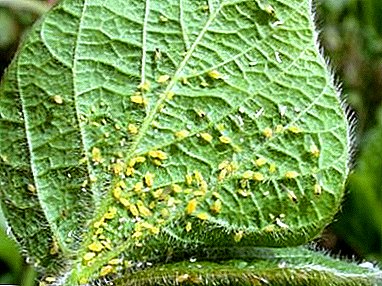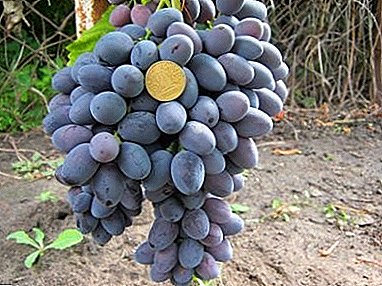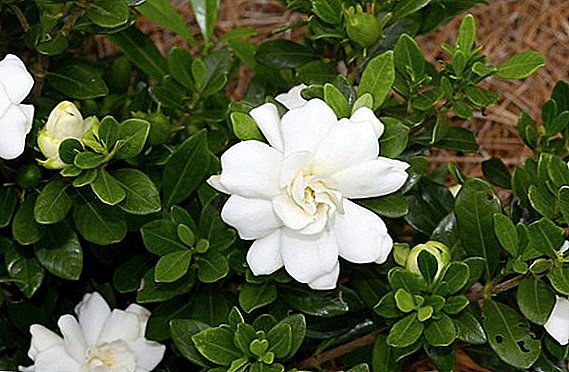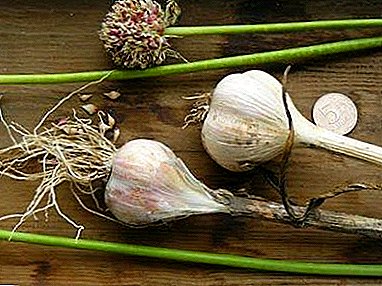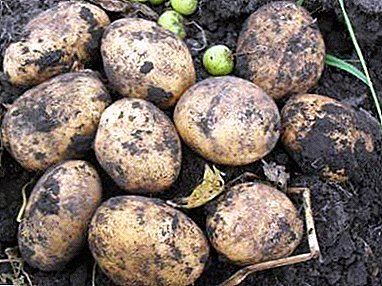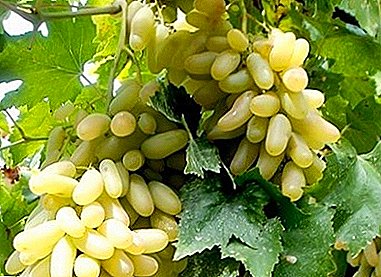
Among the many varieties of grapes there is a variety that has long earned itself extraordinary popularity - it is "Lady's fingers."
Him easy to recognize by the oblong shape of the berries, large elegant clusters and wonderful harmonious taste.
Growing this grape variety requires skillful care, knowledge of all its features and proper protection against possible diseases and pests.
What kind is it?
 Ladies Fingers white grape is rightfully recognized as one of the best table varieties in the world. is he used for fresh use and making great raisins. Grapes belong to the group of Central Asian varieties.
Ladies Fingers white grape is rightfully recognized as one of the best table varieties in the world. is he used for fresh use and making great raisins. Grapes belong to the group of Central Asian varieties.
Among the raisin varieties are also known Karmakod, Kishmish Century and Zest.
It gained its popularity due to excellent taste, excellent presentation and transportability. And the poetic name of the variety was due to the oblong shape of the berries.
However, "Ladies Fingers" is a market name. In professional viticulture, this variety is grown under the name "Husayne White". In Dagestan, it can be found as Shah Raisin, in Russia - "Local", and in Armenia - "Itsaptuk".
Exotic guests from America Black Finger and Witch Fingers look like berries.
Lady's grapes: variety description
Grapes "Ladies Fingers" different large beautiful clusters. They are conical in shape, loose and branched, reaching up to 50 cm in length and up to 26 cm in width.
The beauty of bunches, albeit from a different form, is Romeo, Chocolate and Tayfi.
Average weight one bunch is about 400 g, but sometimes you can find specimens much larger.
The elongated berries are colored yellow-green or yellow-pink. In size, they are quite large, weighing up to 7 g and a length of 4.2 cm.
Elastic thin skin of berries covered with a thin waxy bloom. Crispy and juicy pulp has a pleasant taste.
"Ladies fingers" is inherent in the optimal combination of acidity and sugar content, which gives the brand a unique taste and aroma. Another virtue of the variety is lack of pits.
Varieties of pits are also Marcelo, Kishmish Radiant, Corinka Russian.
Vine has great growth power. It is covered with light green three- or five-fingered leaves of medium size with slightly raised edges.
On the veins of the underside of the leaves there is a slight pubescence. Flowers are bisexual. The varieties with bisexual flowers also belong to Moldova and Buffalo.
A photo
A few photos of the “Lady Fingers” grape variety below:





Breeding history
“Lady fingers” have been growing winegrowers in Central Asia for many centuries. It is assumed that this is a grade obtained by artificial selection after repeated sowing of seeds of wild grapes.
According to Chinese sources, grapes with oblong berries were brought to China from the valley of the river Zaravshan in the first centuries of our era.
Over time, the variety became widespread in Uzbekistan and the countries of Central Asia, from where it was introduced in 1613 to the Astrakhan region. From Uzbekistan, Husayne Bely penetrated the Crimean peninsula.
Currently, it is actively grown in the south of Russia, in the Crimea, Georgia, Uzbekistan, Tajikistan and other countries with a warm climate.
In the middle Russian latitudes, due to low frost resistance, it is grown only by true lovers of this old variety.
Among the thermophilic varieties are also known Hadji Murat, Cardinal and Ruta.
Specifications
 Grade "Ladies Fingers" It has a very high yield, but, unfortunately, is not stable.
Grade "Ladies Fingers" It has a very high yield, but, unfortunately, is not stable.
The excess of moisture or dry summer negatively affects a crop. Under favorable conditions, about 40 tons of grapes can be harvested from 1 ha.
"Husayne White" refers to varieties of medium or even medium late ripening. From the beginning of flowering to full maturity of the berries, it takes from 140 to 150 days.
In warmer and sunny Central Asian countries, the ripening period is reduced to 130 days. In the countries of Central Asia, it is collected in early September.
"Lady fingers" begin to bear fruit on the 5th year of life. However, the partial yield on the bush can be observed earlier than the planned date.
For ripening grapes it takes a lot of sunny and warm days. Therefore, in the middle climatic zone of Russia, "Lady Fingers" do not have time to mature in every summer. Frost varieties weak.
The grapes are able to withstand frost not lower than -11 ° C, therefore, requires careful shelter for the winter, even in the southern regions of Russia.
Diseases and pests
Despite the good yield and excellent quality of fruits, "Lady fingers" are not very popular among winegrowers.
This is due to the extreme instability of the variety - it is difficult to tolerate drought or excessive moisture.
In dry weather to save the vine and to obtain an excellent harvest of grapes regular watering is required.
In the rainy season, fruits can rotting.
During this period, it is necessary to monitor the condition of the ripening crop and remove decaying berries in time, until the rot has passed on to healthy fruits.
 With high humidity, the variety is often affected by oidium or powdery mildewin which yield loss can be up to 80%. On the aerial parts of the vines are formed dirty-gray spots and powdery deposit.
With high humidity, the variety is often affected by oidium or powdery mildewin which yield loss can be up to 80%. On the aerial parts of the vines are formed dirty-gray spots and powdery deposit.
Affected inflorescences die, not having time to open, and the berries stop growing and dry.
A characteristic sign of oidium damage is the peculiar smell of rotting fish.
Measures to combat oidium:
- autumn pruning of dry and damaged vines;
- processing of bushes and soil with iron vitriol before insulation for the winter;
- treatment of spring and summer Bordeaux liquid with the addition of colloidal sulfur;
- foliar nutrition with potassium, phosphorus and trace elements for plant resistance to diseases;
- treatment of grapes during the outbreak of the disease "Fundozol", "Belitol", manganese sour potassium (4 g per 10 l of water) or colloidal sulfur (5 g per 4 l of water).
Protracted fogs and rains contribute to such a fungal disease as mildew or downy mildewhitting the whole green part.
On the shoots, leaves, inflorescences and berries appear yellow oily spots, which after the loss of dew or the last rain covered with a whitish bloom. The affected parts of the vines dry and fall off, and the immature berries rot.
Mature fruits are not affected by mildew, but acquire a sour taste. Because of this disease, you can lose two thirds of the crop.
Mildew control suggests the following measures:
- compliance with conditions for better ventilation of the bush and the inadmissibility of growing grapes in low places;
- prior to flowering, treatment of bushes with Bordeaux liquid is recommended;
- At the first signs of the disease, treatment should be carried out with Efal, Stroviy, Mikal, Sandofan, Oxychloride Copper, etc.
“Lady Fingers” grapes are susceptible to pests such as phylloxera, moth, spider mite, cicada, thrips, weevil, aphid, etc. Wasps, eating juicy flesh, cause great damage to the crop. And after the visit of the birds there are a lot of pecked ripe berries.
The following methods have proven themselves to protect against birds:
- nylon net or metal mesh over the vineyard;
- wind rattles;
- the balls pasted over with mirror pieces;
- strong threads stretched in three tiers between the trellis, in places where the grapes are ripe.
Wasps can be distracted from the grapes with the help of bottles of honey water (1 hl of honey per 1 l of water) placed on the plot.
The more such traps will be installed, the better. It is also necessary to regularly bypass the wasp nests and spray them with "Chlorophos" or "Dichlorvos".
The fight against other pests is as follows:
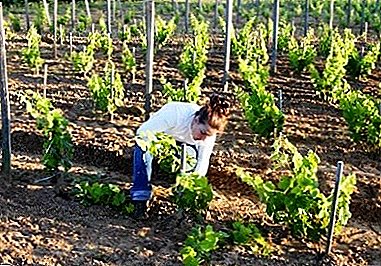 destruction of weeds, regular loosening, annual soil digging;
destruction of weeds, regular loosening, annual soil digging;- cleaning of bushes after winter from old and dry bark with its subsequent burning;
- the uprooting and further burning of diseased bushes;
- after the invasion of phylloxera grapes are not grown in the same place for about 20 years;
- the treatment of plants against ticks, leafworms, thrips, weevil and aphids "Fufanon", "Aktellik", "Alatar", "Aktar";
- spraying of grape bushes from phylloxera and cicadas with the preparations "Karate", "Konfidor", "Kinmiks", "Arrivo";
- from the scoop and crunchy helps the introduction of the "Piper", "Zemlin" or "Basudin" granules in the aisle when digging.
It is necessary to spray plants with plants 2-3 times with an interval of about 10 days during the growing season.. It is important to remember that the last treatment must be made no later than 3 weeks before harvest.
To begin the fight against pests and diseases should be at the first signs of plant damage. Preventive measures will help to avoid problems.
In pest control applied and popular methods. The spider mite is afraid of garlic infusion in the proportion of 200 g per 10 liters of water, and the moth helps to destroy the decoction of onion peel.
"Ladies fingers" are one of the most productive varieties. In terms of crop yields, Podarok Magarach, Jubilee of Kherson Summer Resident and Rkatsiteli compete with him. To get a decent harvest of fragrant and tasty fruits, you need to take into account all the features of the grapes and protect it from possible pests and diseases.


 destruction of weeds, regular loosening, annual soil digging;
destruction of weeds, regular loosening, annual soil digging;
